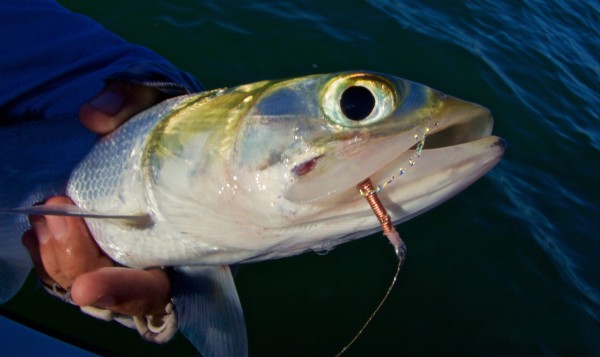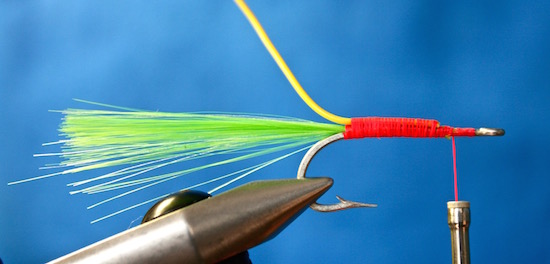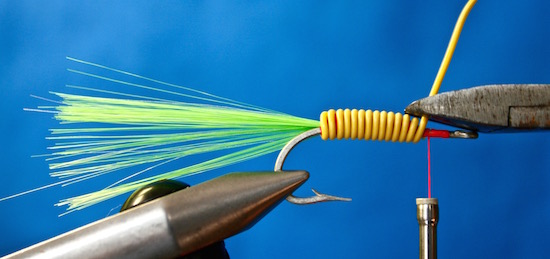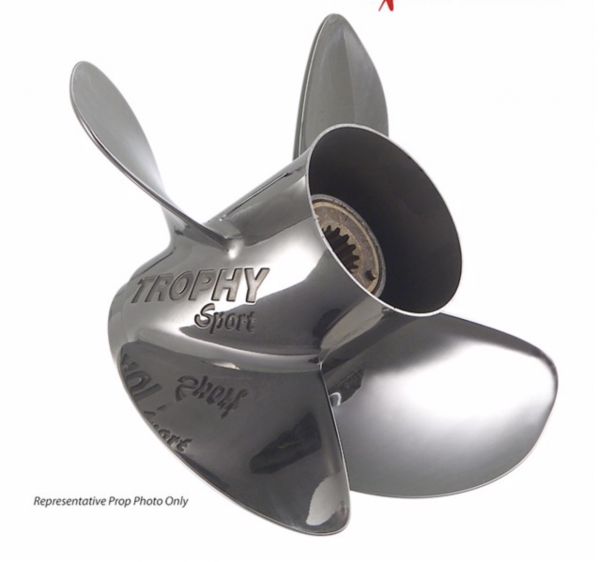Wire Flies
Along Florida beaches we find several species of aggressive and sporty, but fairly small, fishes. Bluefish, ladyfish, and Spanish mackerel, jack crevalle, little tunny, all will gang up on bay anchovies (glass minnows), blasting them at the surface and attracting every tern and gull for miles. When they get going good, the surface gets churned up like a washing machine. We call it a blitz. A blitz is awesome fun on a small fly rod.
If you’re not properly prepared you will quickly go through a lot of flies.
I used to use 30 pound mono for my bite tippet, and routinely go through a dozen or more flies in a couple hours fishing. Fluorocarbon came onto the scene, and I switched. For fish like Spanish mackerel and bluefish fluorocarbon hardly made a difference in how many flies were lost, though.
Tyger Leader came out, and it was a game changer as far as losing flies. The fish couldn’t bite through the wire! Then what happened was, three fish in you’d be fishing with a bare hook. Toothy fish would just shred materials off the hook.
Some tyers use epoxy to armor plate the fly, but I have never liked the stuff. It’s stinky, it’s sticky, it makes a mess if it drips, and I never wanted the rotary drier. For me epoxy was never an option.
I would just tie lots of simple flies and accept attrition as part of the game.
One day I had an idea- why not make the fly itself out of wire? Then toothy fish couldn’t destroy it. It was time to experiment.
In my garage I found several feet of old coated telephone wire. I tried tying some flies with the wire with coating left on, and some more with the bare wire after stripping the coating off. They were simple and not all that beautiful, but I was pretty sure they would work. They were the right size and shape to mimic a glass minnow. The first test they got was on blitzing ladyfish out of Port Canaveral.
Tammy and I each used but a single fly to catch eight or ten big ladyfish. There was no down time tying on new leaders or new flies. The fish did not care whether the wire was still coated or bare- they ate the flies with gusto. Tyger leader, wire fly, fish after fish. The experiment was an outstanding success.
————————————————————–
There are all kinds of wire out there. You can find all different gauges and colors at hardware stores, surplus stores, craft supply stores, etc. The wire must be flexible enough to wrap around a hook, and malleable enough to remain there without being tied down. So far copper wire has had the properties I like best.
Let’s get to the tying instructions.
Materials
Hook- Mustad 3407 or equivalent, # 4, 2, or 1
Thread- tyer’s choice. I like Danville flat waxed nylon in hot red or chartreuse.
Tail- any kind of synthetic wing material. This is a good use for fishair, craft fur, wig extensions, or other types of inexpensive synthetics.
Body- coated or uncoated wire of the tyer’s choice. As I stated above, thin copper wire works well.
1. Place the hook in the vise, start the thread, and wrap it to the bend of the hook. Tie in the tail, no more than half again as long as the hook shank.
2. Lay the end of the wire along the top of the hook shank and tie it down with the thread. Be sure to leave room near the eye of the hook to finish the fly, and wrap the thread up to just behind the eye.
3. Start wrapping the wire around the hook shank. Be sure to cover all the thread wraps at the bend of the hook. Wrap the wire tightly up to the front of the hook, again being sure to leave sufficient room to finish the head of the fly. Use a small wire cutter to clip the wire, then use a small pair of smooth-jawed pliers to twist the nub of the wire tightly against the hook shank. We don’t want any nubby flies!
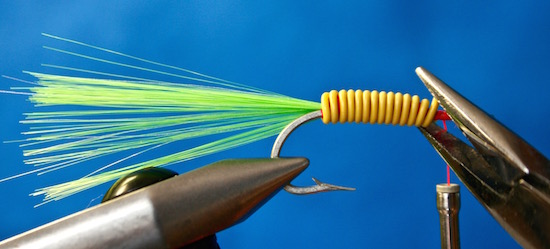
Use smooth-jawed pliers to crush the nub against the hook shank, rotating the pliers around the hook shank as you squeeze them so the wire stays tight.
If you crushed the nub tightly against the hook shank you may not be able to catch it with the thread. If you can catch it, tie it down. If you can’t, the malleability of the wire should hold it in place anyway. Finish and whip the head of the fly. Hit it with the head cement of your choice and you’re done.
I like to trim my tail into a tapered shape. I’m not sure the fish care, though.
I use fingernail polish as head cement. Bluefish and mackerel go right through it, so the head of the fly will unravel. This fly has an Achilles head! Because of the wire, the fly stays together anyway. You can put a glass or metal bead on the hook shank before you start tying, and the bead acts as a thread guard. Another step, and maybe not necessary, but maybe you get a more handsome fly, too. Anyway, it’s another variation, another option.
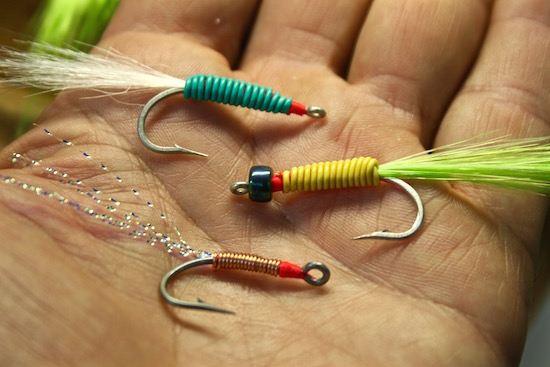
Here are a few different wire flies. The one in the center uses a bead to protect the thread at the head of the fly.
Use the fly on a 10 inch piece of 15 pound Tyger Leader and you can fish Spanish macks or bluefish for hours with the same fly, catching fish after fish in the process. Great stuff!
And that’s how to tie and use wire flies!
John Kumiski
www.spottedtail.com
http://www.spottedtail.com/blog
www.johnkumiski.com
Copyright © John A. Kumiski 2022. It is illegal to reproduce or distribute this work in any manner or medium without written permission from the author, John A. Kumiski, 284 Clearview Road, Chuluota, FL 32766 (407) 977-5207.
If you found this article useful and would like to donate to Spotted Tail, please click here…

